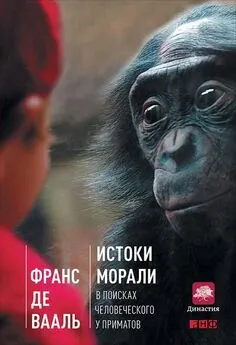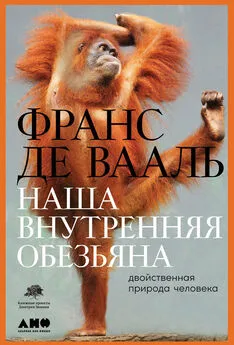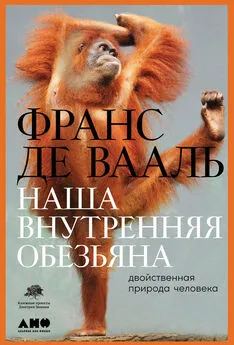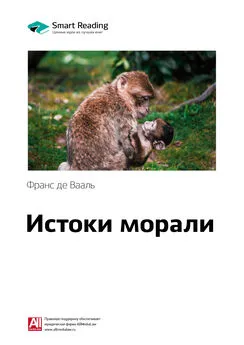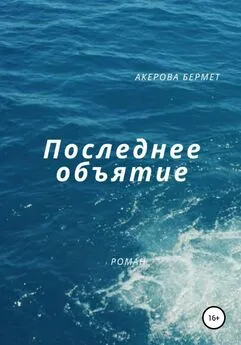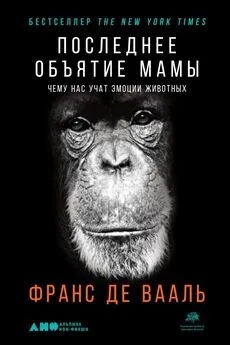Франс Вааль - Последнее объятие Мамы [litres]
- Название:Последнее объятие Мамы [litres]
- Автор:
- Жанр:
- Издательство:Литагент Альпина
- Год:2020
- Город:Москва
- ISBN:978-5-0013-9214-9
- Рейтинг:
- Избранное:Добавить в избранное
-
Отзывы:
-
Ваша оценка:
Франс Вааль - Последнее объятие Мамы [litres] краткое содержание
В этой доброй и умной книге, помимо трогательной истории шимпанзе по имени Мама, известный приматолог Франс де Вааль рассказывает о своих многочисленных наблюдениях и экспериментах, посвященных изучению эмоций самых разных животных. Наряду с гневом и ненавистью, приводящими даже к преднамеренному убийству себе подобных, животные обнаруживают удивительную способность к состраданию, примирению и прощению. Они, как и мы, способны к эмпатии, взаимопомощи и тесному социальному взаимодействию.
Автор рассматривает чувства человека в эволюционном контексте как прямое продолжение эмоций животных и призывает осознать нашу неразрывную связь со всеми существами на планете и в конечном счете лучше понять самих себя.
Последнее объятие Мамы [litres] - читать онлайн бесплатно ознакомительный отрывок
Интервал:
Закладка:
Payne, K. 1998. Silent Thunder: In the Presence of Elephants . New York: Simon and Schuster.
Pepperberg, I. M. 2008. Alex and Me. New York: Collins.
Perry, S., et al. 2003. Social conventions in wild white-faced capuchin monkeys: Evidence for traditions in a neotropical primate. Current Anthropology 44:241–68.
Pinker, S. 2011. The Better Angels of Our Nature: Why Violence Has Declined . New York: Viking.
Pittman, J., and A. Piato. 2017. Developing zebrafish depression-related models. In The Rights and Wrongs of Zebrafish: Behavioral Phenotyping of Zebrafish , ed. A. V. Kalueff, 33–43. Cham: Springer.
Plotnik, J. M., and F. B. M. de Waal. 2014. Asian elephants (Elephas maximus) reassure others in distress. PeerJ 2: e278.
Plotnik, J. M., F. B. M. de Waal, and D. Reiss. 2006. Self-recognition in an Asian elephant. Proceedings of the National Academy of Sciences USA 103:17053–57.
Premack, D., and A. J. Premack. 1994. Levels of causal understanding in chimpanzees and children. Cognition 50:347–62.
Proctor, D., R. A. Williamson, F. B. M. de Waal, and S. F. Brosnan. 2013. Chimpanzees play the Ultimatum Game. Proceedings of the National Academy of Sciences USA 110:2070–75.
Proust, M. 1982. Remembrance of Things Past , 3 vols. New York: Vintage Press.
Provine, R. R. 2000. Laughter: A Scientific Investigation . New York: Viking.
Pruetz, J. D., et al. 2017. Intragroup lethal aggression in West African chimpanzees ( Pan troglodytes verus ): Inferred killing of a former alpha male at Fongoli, Senegal. International Journal of Primatology 38:31–57.
Range, F., L. Horn, Z. Viranyi, and L. Huber. 2008. The absence of reward induces inequity aversion in dogs. Proceedings of the National Academy of Sciences USA 106:340–45.
Rawls, J. 1972. A Theory of Justice . Oxford: Oxford University Press.
Rilling, J. K., et al. 2011. Differences between chimpanzees and bonobos in neural systems supporting social cognition. Social Cognitive and Affective Neuroscience 7:369–79.
Romero, T., M. A. Castellanos, and F. B. M. de Waal. 2010. Consolation as possible expression of sympathetic concern among chimpanzees. Proceedings of the National Academy of Sciences 107:12110–15.
Rowlands, M. 2009. The Philosopher and the Wolf: Lessons from the Wild on Love, Death and Happiness . New York: Pegasus.
Rozin, P., J. Haidt, and C. McCauley. 2000. Disgust. In Handbook of Emotions , ed. M. Lewis and S. M. Haviland-Jones, 637–53. New York: Guilford.
Sakai, T. et al. 2012. Fetal brain development in chimpanzees versus humans. Current Biology 22: R791 – R792.
Salovey, P., M. Kokkonen, P. N. Lopes, and J. D. Mayer. 2003. Emotional intelligence. In Feelings and Emotions: The Amsterdam Symposium , eds. T. Manstead, N. Frijda, and A. Fischer, 321–340. Cambridge: Cambridge University Press.
Sanfey, A. G., J. K. Rilling, J. A. Aronson, L. E. Nystrom, and J. D. Cohen. 2003. The neural basis of economic decision-making in the ultimatum game. Science 300:1755–58.
Sapolsky, R. M. 2017. Behave: The Biology of Humans at Our Best and Worst . New York: Penguin.
Sarabian, C., and A. J. J. MacIntosh. 2015. Hygienic tendencies correlate with low geohelminth infection in free-ranging macaques. Biology Letters 11:20150757.
Sarabian, C., R. Belais, and A. J. J. MacIntosh. 2018. Feeding decisions under contamination risk in bonobos. Philosophical Transactions of the Royal Society B 373.
Sato, N., L. Tan, K. Tate, and M. Okada. 2015. Rats demonstrate helping behavior toward a soaked conspecific. Animal Cognition 18:1039–47.
Sauter, D. A., O. LeGuen, and D. B. M. Haun. 2011. Categorical perception of emotional facial expressions does not require lexical categories. Emotion 11:1479–83.
Scheele, D., et al. 2012. Oxytocin modulates social distance between males and females. Journal of Neuroscience 32:16074–79.
Schilder, M. B. H., et al. 1984. A quantitative analysis of facial expression in the plains zebra. Zeitschrift für Tierpsychologie 66:11–32.
Schilthuizen, M. 2018. Darwin Comes to Town: How the Urban Jungle Drives Evolution . New York: Picador.
Schneiderman, I., et al. 2012. Oxytocin during the initial stages of romantic attachment: Relations to couples’ interactive reciprocity. Psychoneuroendocrinology 37:1277–85.
Schoeck, H. 1987. Envy: A Theory of Social Behaviour. Indianapolis: Liberty Fund.
Schwing, R., X. J. Nelson, A. Wein, and S. Parsons. 2017. Positive emotional contagion in a New Zealand parrot. Current Biology 27: R213 – R214.
Shapiro, J. A. 2011. Evolution: A View from the 21st Century . Upper Saddle River, NJ: FT Press Science.
Sherif, M., et al. 1954. Experimental study of positive and negative intergroup attitudes between experimentally produced groups: Robbers’ Cave Study . Norman: University of Oklahoma Press.
Sherman, R. 2017. Uneasy Street: The Anxieties of Affluence . Princeton, NJ: Princeton University Press.
Singer, T., B. Seymour, J. P. O’Doherty, K. E. Stephan, R. J. Dolan, and C. D. Frith. 2006. Empathic neural responses are modulated by the perceived fairness of others. Nature 439:466–69.
Skinner, B. F. 1965 [1953]. Science and Human Behavior . New York: Free Press.
Sliwa, J., and W. A. Freiwald. 2017. A dedicated network for social interaction processing in the primate brain. Science 356:745–49.
Smith, A. 1937 [orig. 1759]. A Theory of Moral Sentiments . New York: Modern Library.
–. 1982 [orig. 1776]. An Inquiry into the Nature and Causes of the Wealth of Nations . Indianapolis: Liberty Classics.
Smith, J. D., J. Schull, J. Strote, K. McGee, R. Egnor, and L. Erb. 1995. The uncertain response in the bottlenosed dolphin (Tursiops truncatus). Journal of Experimental Psychology: General 124:391–408.
Sneddon, L. U. 2003. Evidence for pain in fish: The use of morphine as an analgesic. Applied Animal Behaviour Science 83:153–62.
Sneddon, L. U., V. A. Braithwaite, and M. J. Gentle. 2003. Do fishes have nociceptors? Evidence for the evolution of a vertebrate sensory system. Proceedings of the Royal Society, London B 270:1115–21.
Springsteen, B. 2016. Born to Run . New York: Simon and Schuster.
Stanford, C. B. 2001. Significant Others: The Ape-Human Continuum and the Quest for Human Nature . New York: Basic Books.
Stomp, M., et al. 2018. An unexpected acoustic indicator of positive emotions in horses. PLoS ONE 13: e0197898.
Suchak, M., and F. B. M. de Waal. 2012. Monkeys benefit from reciprocity without the cognitive burden. Proceedings of the National Academy of Sciences USA 109:15191–96.
Tan, J., and B. Hare. 2013. Bonobos share with strangers. PloS ONE 8: e51922.
Tan, J., D. Ariely, and B. Hare. 2017. Bonobos respond prosocially toward members of other groups. Scientific Reports 7:14733.
Tangney, J., and R. Dearing. 2002. Shame and Guilt . New York: Guilford.
Teleki, G. 1973. Group response to the accidental death of a chimpanzee in Gombe National Park, Tanzania. Folia primatologica 20:81–94.
Tinklepaugh, O. L. 1928. An experimental study of representative factors in monkeys. Journal of Comparative Psychology 8:197–236.
Tokuyama, N., and T. Furuichi. 2017. Do friends help each other? Patterns of female coalition formation in wild bonobos at Wamba. Animal Behaviour 119:27–35.
Tolstoy, L. 1975 [orig. 1904]. The Lion and the Dog . Moscow: Progress Publishers.
Tottenham, N., et al. 2010. Prolonged institutional rearing is associated with atypically large amygdala volume and difficulties in emotion regulation. Developmental Science 13:46–61.
Tracy, J. 2016. Take Pride: Why the Deadliest Sin Holds the Secret to Human Success . New York: Houghton.
Tracy, J. L., and D. Matsumoto. 2008. The spontaneous expression of pride and shame: Evidence for biologically innate nonverbal displays. Proceedings of the National Academy of Sciences USA 105:11655–60.
Troje, N. F. 2002. Decomposing biological motion: A framework for analysis and synthesis of human gait patterns. Journal of Vision 2:371–87.
Tybur, J. M., D. Lieberman, and V. Griskevicius. 2009. Microbes, mating, and morality: Individual differences in three functional domains of disgust. Journal of Personality and Social Psychology 97:103–22.
van de Waal, E., C. Borgeaud, and A. Whiten. 2013. Potent social learning and conformity shape a wild primate’s foraging decisions. Science 340:483–85.
van Hooff, J. A. R. A. M. 1972. A comparative approach to the phylogeny of laughter and smiling. In Non-verbal Communication , ed. R. Hinde, 209–241. Cambridge: Cambridge University Press.
van Leeuwen, P., et al. 2009. Influence of paced maternal breathing on fetalmaternal heart rate coordination. Proceedings of the National Academy of Sciences USA 106:13661–66.
van Schaik, C. P., L. Damerius, and K. Isler. 2013. Wild orangutan males plan and communicate their travel direction one day in advance. PLoS ONE 8: e74896.
van Wyhe, J., P. C. Kjærgaard. 2015. Going the whole orang: Darwin, Wallace and the natural history of orangutans. Studies in History and Philosophy of Biological and Biomedical Sciences 51:53–63.
Vianna, D. M., and P. Carrive. 2005. Changes in cutaneous and body temperature during and after conditioned fear to context in the rat. European Journal of Neuroscience 21:2505–12.
Wagner, K., et al. 2015. Effects of mother versus artificial rearing during the first 12 weeks of life on challenge responses of dairy cows. Applied Animal Behaviour Science 164:1–11.
Walsh, G. V. 1992. Rawls and envy. Reason Papers 17:3–28.
Warneken, F., and M. Tomasello. 2014. Extrinsic rewards undermine altruistic tendencies in 20-month-olds. Motivation Science 1:43–48.
Wathan, J., et al. 2015. EquiFACS: The Equine Facial Action Coding System. PLoS ONE 10: e0131738.
Watson, J. B. 1913. Psychology as the behaviorist views it. Psychological Review 20:158–77.
Westermarck, E. 1912 [orig. 1908]. The Origin and Development of the Moral Ideas . Vol. 1. 2nd ed. London: Macmillan.
Wilkinson, R. 2001. Mind the Gap . New Haven, CT: Yale University Press.
Wilson, M. L., et al. 2014. Lethal aggression in Pan is better explained by adaptive strategies than human impacts. Nature 513:414–17.
Wispé, L. 1991. The Psychology of Sympathy . New York: Plenum.
Woodward, R., and C. Bernstein. 1976. The Final Days . New York: Simon and Schuster.
Wrangham, R. W. 2009. Catching Fire: How Cooking Made Us Human . New York: Basic Books.
Wrangham, R. W., and D. Peterson. 1996. Demonic Males: Apes and the Evolution of Human Aggression . Boston: Houghton Mifflin.
Yamamoto, S., T. Humle, and M. Tanaka. 2012. Chimpanzees’ flexible targeted helping based on an understanding of conspecifics’ goals. Proceedings of the National Academy of Sciences USA 109:3588–92.
Yerkes, R. M. 1941. Conjugal contrasts among chimpanzees. Journal of Abnormal and Social Psychology 36:175–99.
Yokawa, K., et al. 2017. Anaesthetics stop diverse plant organ movements, affect endocytic vesicle recycling and ROS homeostasis, and block action potentials in Venus flytraps. Annals of Botany : mcx155.
Читать дальшеИнтервал:
Закладка:
![Обложка книги Франс Вааль - Последнее объятие Мамы [litres]](/books/1075030/frans-vaal-poslednee-obyatie-mamy-litres.webp)

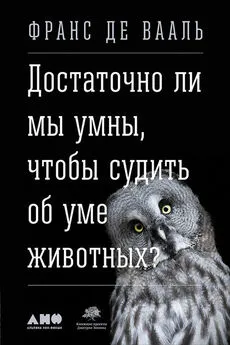
![Дебра Мерк - Девочка в гараже [Реальная история приемной мамы] [litres]](/books/1060538/debra-merk-devochka-v-garazhe-realnaya-istoriya-prie.webp)
